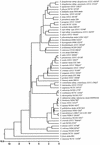What happened to the streptococci: overview of taxonomic and nomenclature changes
- PMID: 12364372
- PMCID: PMC126867
- DOI: 10.1128/CMR.15.4.613-630.2002
What happened to the streptococci: overview of taxonomic and nomenclature changes
Abstract
Since the division of the Streptococcus genus into enterococci, lactococci, and streptococci in 1984, many changes in the nomenclature and taxonomy of the Streptococcus genus have taken place. The application of genetic comparisons has improved the proper classification of the different species. The Lancefield system of serogrouping the streptococci by the expression of beta-hemolysis on blood agar plates is still very useful for the identification of streptococci for patient management. The Lancefield grouping system cannot be used in itself for accurate identification of specific beta-hemolytic species, but it can be a useful part of the identification procedure. Except for identification of the "Streptococcus bovis group" of species and Streptococcus suis, Lancefield grouping is of little value in identification of the non-beta-hemolytic streptococci and related genera. In fact, identification of the non-beta-hemolytic species is problematic for conventional as well as commercially available identification procedures. A combination of conventional tests and specific chromogenic tests suggested by several investigators is presented and discussed. Tables are included that suggest tests and procedures to guide investigators attempting to identify all the species.
Figures
References
-
- Alcaide, F., M. A. Benitez, J. Carratala, F. Gudiol, J. Linares, and R. Martin. 2001. In vitro activities of the new ketolide HMR 3647 (telithromycin) in comparison with those of eight other antibiotics against viridans group streptococci isolated from blood of neutropenic patients with cancer. Antimicrob. Agents Chemother. 45:624-626. - PMC - PubMed
-
- Baele, M., V. Storms, F. Haesebrouck, L. A. Devriese, M. Gillis, G. Verschraegen, T. De Baere, and M. Vaneechoutte. 2001. Application and evaluation of the interlaboratory reproducibility of tRNA intergenic length polymorphism analysis (tDNA-PCR) for identification of streptococcus species. J. Clin. Microbiol. 39:1436-1442. - PMC - PubMed
-
- Balter, S., A. Benin, S. W. L. Pinto, L. M. Teixeira, G. G. Alvim, E. Luna, D. Jackson, L. LaClaire, J. Elliott, R. Facklam, and A. Schuchat. 2000. Epidemic nephritis in Nova Serrana, Brazil. Lancet 355:1776-1780. - PubMed
Publication types
MeSH terms
LinkOut - more resources
Full Text Sources
Other Literature Sources


